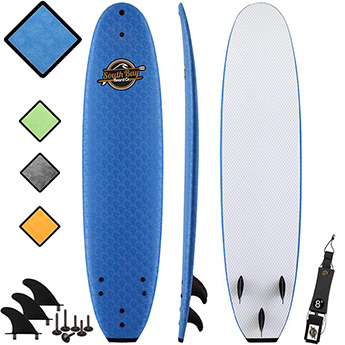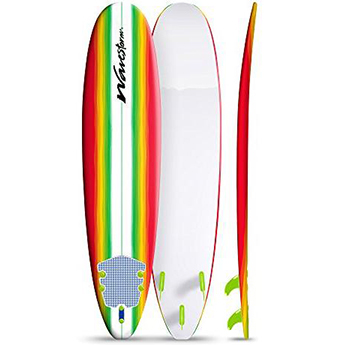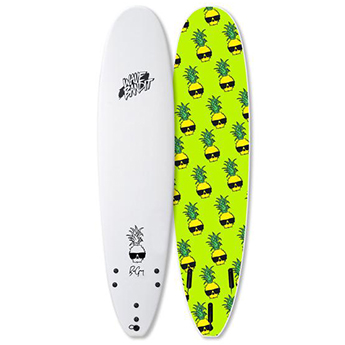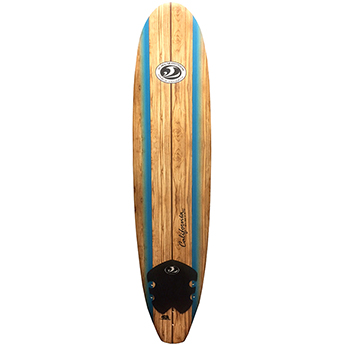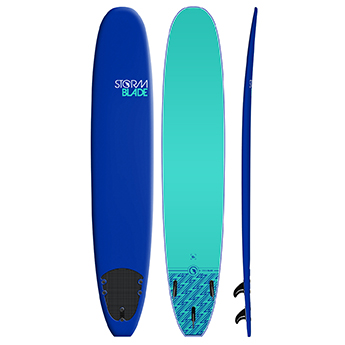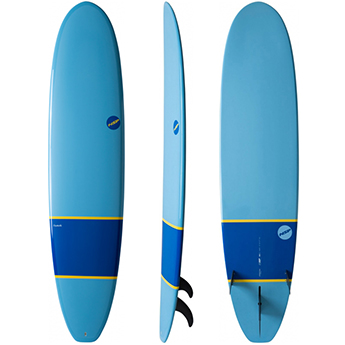While many surfers think that they can just take out any old longboard to catch some serious waves, choosing the wrong one can be the difference between a good day and a bad day out on the water.
Not all longboards are created equal. Some are made with better materials than others and have a better shape.
You don’t want to buy a longboard you won’t be happy with, right? Of course not! You want a board that is not only fun and exciting to ride, but is great quality as well.
Did you know you also don’t have to pay a fortune for a great longboard?
There are brands of longboard surfboards that offer expert board shaping, quality and affordable prices all bundled into one great buy!
To take the grunt work out of longboard research for you, we have created a review of the best longboard surfboards you will find on the market.
Get reading and get surfing!
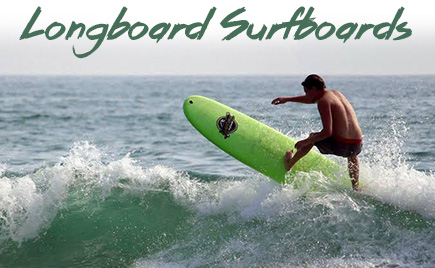
Contents
- 1 Best Longboards On The Market
- 2 The 6 Best Longboard Surfboards
- 3 Longboard Surfboard Size Chart
- 4 Choosing Your Longboard
- 5 Beginners Guide To Longboard Surfing
- 6 Longboard Surfing Tricks
- 7 Must-Have Longboard Surfboard Accessories
- 8 Longboard Surfboard Pros and Cons
- 9 FAQ
- 10 Final Thoughts - Which Should You Get?
Best Longboards On The Market
The 8’ Verve is versatile, capable of being ridden in small, mushy waves or head high hollow tubes. It’s durability makes it a long lasting board and it’s traditional longboard shape will give you a retro ride reminiscent of the 60’s boards.
The closed cell foam core of the board is waterproof and will not waterlog the board. Because it is vacuum molded, instead of heat laminated together, it is much more durable than the average longboard.
The triple stringer inside the internal foam core also maintains board strength and shape, so breaking will not be an issue.
The foam core is wrapped with ground breaking technology called Fingerprint-textured IXPE Foam. It is waterproof and textured, so no need to wax the deck!
The bottom of the board is made with the strongest high density polyethylene. It’s damage proof, rigid and strong. You won’t need to stress about dings or scratches with this board. The bottom of the board is also double concave for a high performance ride.
The SBBC 8’ also has a bit more nose rocker, making it more responsive and easy to turn than most beginner longboards. This means they can be surfed by all levels of surfers!
This board comes with its own set of find, with the fin holes being lined and waterproof. They are easy to install, as well. A leash and fin hardware are also included. This is a great deal for such a good board with so many accessories.
#2 Best Beginner Longboard Surfboard: Wavestorm Classic 8’
If you want the best longboard for beginners, look no further. Wavestorm has been the leading brand for beginner foam surfboards for years.
You can find them almost anywhere, from Costco stores to Amazon.com.
The 8’ is made with lightweight foam, so it is easy to get it to the beach. It’s extra thick which gives it great buoyancy to get into waves.
The rails are nice and sharp, great for maintaining a riding in smaller white wash. Learning how to stand and balance with this board will feel much more natural.
The EPS foam core is incredibly strong and soft, and also waterproof.
You won’t have to worry about the board getting waterlogged or rotting from moisture. The slick HDPE bottom deck means protection from damage like scratches or tears.
WAvestorm 8’ comes with intuitive pop-through fins and a leash. A traction pad for your back foot in also pre attached on the top deck. You can’t beat the deal you’ll get when purchasing this board.
#3 Wave Bandit Gravy Rider 8’
This foam top is a versatile design and can be enjoyed by everyone.
Wave Bandit as a brand is unique and fun and offers boards and vibes unlike any other. Buyers will appreciate the performance and maneuverability of the Gravy Rider 8’.
The shapers who made this board pulled in the nose and tail a little to make them more narrow. You won’t dig your rails or pearl with this foamie.
It still has plenty of volume and buoyancy though, so it is still great for getting into waves easily and offers great stability.
This board rides great but is also durable as heck.
The bottom deck maintains rigidity and strength by being made from scratch resistant polyethylene.
The core is made out of EPS foam, which is waterproof and is highly resistant to tears and punctures. Double maple wood stringers are waterproof and ensure that your Ben Gravy EZ Rider 8’ will not break or decline in shape or performance.
The best aspect of this board? It’s awesome graphics designed by pro surfer Ben Gravy himself.
The bottom of the board is tiled with a cool pineapple wearing sleek shades over a backdrop of bright yellow.
The pop-through fins are a nice contrasting black and they are easy to install. The holes for the fins are lined and waterproof as well.
Every Gravy EZ Rider comes complete with a leash and leash string as well. Once you get your hands on this board, you’ll be ready to charge the waves immediately.
If you want a cool retro looking board I would suggest the 9’ California Board Company bolsa graphic board.
The wood laminate is reminiscent of the exciting innovations of surfing in the 60’s and will offer a true Malibu spirit.
Though it looks like wood, it’s actually made with high grade EPS foam. 100% waterproof and extremely resistant to damage like holes and scratches.
It’s wide, thick and buoyant so it will be easy to learn to catch waves on.
With a round nose and a wide tail, the board provides optimal balance and stability.
I would recommend this board for a large teen or an average to large sized adult because it has so much length and buoyancy
If the beautiful graphics were not incentive enough to get this board, it also comes with three fins with waterproof nylon screws, and they are easy to install. The leash and string that come with this board are also high quality and will have you ready to surf in no time!
Stormblade is a truly unique brand, developing board designs for many years into the perfect longboard for beginners.
The 9’ longboard is perhaps the best beginner surfboard they offer, and would be a great buy.
The high volume is great for beginners, while the round rails will have advanced surfers gliding down the wave in style.
You can use this board when you are learning to pop up in the whitewash, or carve up and down the face of big outside waves.
Stormblade is not a brand to skimp on materials. They use the highest quality EPS foam for the top deck that is strong and waterproof.
The high density polyethylene bottom deck is hydrodynamic and resistant to damage. As for the top layer of the board, you get 4mm thick EBS-IXL foam that will keep the board looking new for years to come. The wooden stringers are three marine ply in design, helping to provide security against breakage.
The fins are also waterproof and easy to install. They fit into sealed and waterproof pop through holes that also prevent waterlogging. The double swivel leash is included with purchase, along with a leash string for attachment to the board.
Stormblade 9’ can ride virtually any type of wave and can be used by surfers at every ability level. And with all the added accessories it comes with, you can’t argue this board to be an amazing addition to anyone's quiver.
The NSP Elements is one of the most sought after foam longboards on the market. It’s not surprising, due to its innovative designs and high quality materials.
The boards are perfectly shaped to be exciting with serious longevity, great for any kind of wave and surfer.
The Elements model is a perfect reflection of why NSP is such a great brand.
The internal foam core is molded with strong epoxy resin and 100% waterproof. The bottom portion is made with slick HDPE.
The strong and double concave shape makes this board very responsive.
You won’t have to worry about damage to the board when it is made this tough.
This board purchase includes an 8” center fin made of nylon and two M3 side fins from FCS to make a high performance 2 + 1 fin template. The fins are long lasting and can be installed in a pinch. If you’re looking for a solid surfboard for beginners that will stick with you as your abilities grow, the NSP Elements Longboard should be on your radar.
Longboard Surfboard Size Chart
Different heights and weights of surfers will require a different amount of buoyancy, length and volume in a surfboard. If you get a board that is too small to float you, it will be very hard to learn to get into waves. If a board is too big for the surfer, it will be near impossible to learn to turn. Below is a comprehensive surfboard size chart for kids and adults.
Surfer's Weight | Beginner | Intermediate |
|---|---|---|
< 55 kg | 6'8" - 7'2" | 6'8" - 7'0" |
55 - 65 kg | 7'2" - 7'6" | 6'10" - 7'2" |
65 - 75 kg | 8'0" - 8'6" | 7'0" - 7'6" |
75 - 85 kg | 8'6" - 9'2" | 7'6" - 8'0" |
85 - 95 kg | 9'2" - 9'6" | 8'0" - 8'6" |
95 kg+ | 9'6" + | 8'6" - 9'2" |
Choosing Your Longboard
Length
Longboards have more surface area, making them really good for gliding on the water and catching waves. They also move slower as they get longer, which is good for learners. They are traditional 8’ and longer, with decks that are usually 22” or wider. Longboards are not typically good at sharp turns or speed however. They can also be more difficult to maneuver, as there is so much more board to turn.
If you want a board that turns quick and plains down the wave at faster speeds, you will want a shorter board. The shorter the board, the easier turning will be and the faster it will surf. It just depends on the style of surfing you are going for and what your ability is.
Board Shape and Design
When you’re looking at boards from 6’6” to 7’6”, you can refer to them as “fun boards.” These boards are ridden by novice surfers, but can be ridden by short board enthusiasts because of how fast they can turn and how well they duck dive.
Traditional “shortboards” are usually 6’6” and smaller. They don’t have nearly as much buoyancy, making them more difficult to get into waves, but advanced surfers have developed the muscle to paddle to they don’t need as much buoyancy. They are loose and responsive, so more advanced surfers love them.
Traditional longboards are the longest type of board is a “longboard,” they are about 7’6”’ and longer. They are wide, thick and have round noses. The tails are usually wider as well. What you lose in maneuverability, you can in balance, control and stability.
Fish boards are a type of shortboard in length, but are shaped a little different. They are wider, with noses that are slightly rounded and have what’s called a fish tail because it splits into two like the animal’s. They are much thicker too, so they are buoyant and get into waves well. Fish boards are typically one tier down from a funboard.
Though they are short, they offer a slower, mellow smoother ride than a high performance shortboard. With a fish tail, you can gain extra surface area without adding bulk to the board. The wider tail gives more stability while turning, too.
Rails
There are hard rails and soft rails. Soft rails are better for going in a straight line, and can sink into the wave a little while turning. This makes the board “stiff,” which is great if you want to maintain your direction in the waves or learn to surf. That’s why soft rails are typically used with longboards. Hard rails make the board much looser, meaning it’s easy to turn, but the board doesn’t keep its line down the wave as well. This is good is you want a board that turns really fast and is super maneuverable without much effort.
Tail
There are five basic tail shapes: pin tails, round tails, squash tails, fish/swallow tails and square tails. Pin tails offer the most stability and will not change the boards direction easily. For boards like those ridden in giant waves where you need to maintain your direction, this tail type is imperative. With a reduced surface area in the tail, you reduce the risk of digging the rails into the wave, so it will increase your balance.
Rounded tails are great for boards that are looser and more maneuverable. Round tails make the board much easier to turn with, but are harder to balance on, as the board can change direction very easily.
A squash and square tail has the most surface area, making it the easiest tail to turn. Square tails and squash tails are typically used on traditional longboards. They make up for how long the board is by making them easier to turn.
Fish tails are most appropriate for smaller and softer waves without much speed or power. Reduced speed and power in the face of the wave can make balancing harder, so the large width of the fish tail compensates for that, as it is easy to turn. The rails on the tips of the fish tail are hard, giving the board extra stability while maintaining maneuverability.
Rocker
Rocker is used so the tail and nose don’t dig into the water and make you wipe out. Longboards usually have less rocker, making them good for getting into waves but they pearl easier. Shortboards usually have a lot of rocker. This makes it harder to get into waves, but you won’t have to worry about pearling as you carve up and down the wave.
Fin Types
There are four basic types of fin set ups: single fin, thruster, twin fin and quad fin. Generally, larger fins go with larger boards, and smaller fins go with smaller boards, but any shape of board can have different ways the fins are set up. Boards can have up to five fins in one set up.
Single fin set ups can traditionally be found on longboards. The turns are slower and longer, and having one fin is good for maintaining your line. This can make turning a little harder with a single fin, however.
A thruster fin set up is a board with two side fins and a middle fin. This is a very maneuverable setup. These fins are much smaller, which makes the ride looser and the board more responsive. Typically used for aggressive turning and intense carving.
The twin fin set up goes with boards that have the swallow or fish tail. There is no need for a middle fin as seen in thruster set ups because the V shape cuts the middle material out of the tail where the third fin would usually go.
Quad fin set ups provide the loosest ride, with two smaller fins on either side of the tail end. The fins are the smallest in any set up, making them good for sharp turns and responsiveness. The aren’t the best for large waves, as they don’t hold the board in balance very well. On waves that are smaller and easier, where balance isn’t as much of an issue, quad set ups are great. You will put minimal effort into turning and carving.
Beginners Guide To Longboard Surfing
Longboard is easier to learn on than shortboards, but harder to master. This is because the level of balance and gracefulness needed to be an advanced surfer is very intense and intricate. But learning on a longboard couldn’t be easier.
The great thing about learning on a longboard is you can stick with it forever, mastering tricks like walking the nose and hanging ten, or switch to shortboarding once you get the hang of catching and riding waves. Below is an easy to follow step by step guide to learning to longboard surfing:
Getting into waves
If you have a board that is wide and has great buoyancy, it will be a much faster process to learn surfing. I recommend a board that is at least 7’-8’ for adults, like the Wavestorm Classic 8'. If you are a larger adult, or heavier than average, I would go all the way up to 9’ long like the California Board Company 9' longboard. This will make it easier to gain speed and match the wave’s momentum. Matching your speed as closely as you can to the wave’s is how you get picked up into the curl, at which point you can pop up.
Don’t take off too early or too late
If you have an instructor, they can teach you when to start paddling in relation to how close the wave is to you. If you are learning on your own, you can experiment with how soon or late you start paddling so you can get an idea of when your board gets into waves the most successfully. If you paddle too soon, the wave will crash on you, resulting in pearling and wipe outs. Paddle too late, and the energy of the wave will go right under you, causing you to miss the wave.
Popping up
Once you can feel the energy of the wave moving you and you don’t have to paddle anymore, pop up as fast as you can. If you wait to long to pop up, it will be harder to balance and you most likely will fall. Popping up can be taught by surf instructors, but you can also find tutorials like this one on sites like YouTube.
Riding the wave
Once you’ve popped up, make sure your stance is wide and your feet are in the correct place. If you have a good pop up technique, you’re feet will naturally land where they need to. Once you get your balance, you can start practicing trimming and turning. Eventually, you will have so much practice that you can try harder moves like hanging your toes over the board’s nose. Good luck with your longboarding journey and have fun!
Longboard Surfing Tricks
Longboards aren’t typically known for big airs, bashing the lip, or other shortboard tricks. Instead, they are meant to travel in a relatively straight line down the wave so you can do things like “walk the board” or ‘hang ten.”
Walking the board is fun and my personal favorite longboard activity. Once you have popped up and have a good spot on the wave, you can cross one foot over the other until you are at the top of the board, towards the nose. You can cross step back down to the tail, too. Where you step on the board all depends on where you are in the pocket of the wave.
Hanging ten is the most fun thing to do. You have all ten toes over longboard’s nose after you have walked the board all the way to the top. Because you can’t see the board underneath you at this point, it feels as if you are gliding over the water with nothing underneath you. It’s the coolest feeling ever.
Must-Have Longboard Surfboard Accessories
Leashes are a must have. Even if you are an advanced surfer, it’s always a good idea to paddle out with one. If you lose your board, it could hit another surfer, causing injury and at the very least, an enemy in the line up. In tougher surf, you don’t want to get stuck in the ocean without your board, as it can be very hard to swim back to shore with heavy currents and rip tides.
Traction pads are an option of accessory that gives your back foot extra balance while surfing. The pad has a high amount of bumpy traction, so you won’t have to worry about your back foot slipping or falling off the board while turning.
One great way to protect the deck of your longboard is by getting a board sock or bag. This will reduce the instance of scratching or holes while you are transporting the board to the break. Super padded board bags are essential if you are planning to bring your board on an airplane. The airport staff will throw your board around just as much as any other luggage, and it’s important to have some kind of protection.
For boards with slick top decks, wax will help you keep your feet on the board. The two most popular brands are “Sex Wax” and “Sticky Bumps.” You can find surf wax at any surf shop or online.
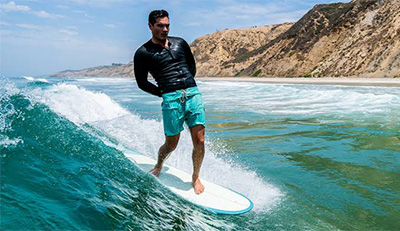
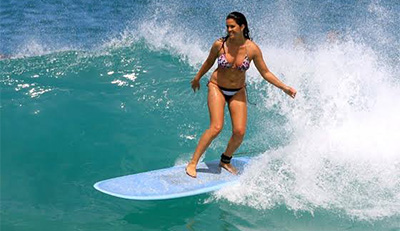
Longboard Surfboard Pros and Cons
FAQ
Are Longboard Surfboards For Beginners?
Longboards generally have enough volume and surface area that they make great beginner boards. Foam top longboards are even better, because they are softer, and thus safer. Longboards travel down the wave at a slower speed than short boards, so you will have more time for practicing your balance and turning.
Should I Apply Wax On My Soft-Top Longboard?
Many soft top surfboards come with a top deck with a lot of traction. Some, however are very slick and will need some kind of surf wax.
Do I Need Prior Athletic Training Before I Start Surfing?
Anyone at any level of fitness and athletic ability can take up surfing. Surfing is not an intuitive process, and even the most athletically gifted individual will have a hard time learning to stand on moving water. Though surfing can be challenging to learn, it is one of the funnest, most addicting activities to do. You’ll thank your lucky stars you got one of the surfboards on our list and started surfing.
Cross training, like other sports, running and lap swimming, can be great ways to remain in shape for surfing. Surfing itself is a great way to get better though, and the more time you spend in the water, the better you will be at it.
Are There Rules I Should Be Aware Of In The Lineup?
Surf etiquette is everything. Being in the ocean can be an intense experience and requires focus and the utmost awareness of your surroundings. To keep you and others safe in the water, keep these surf etiquette rules in mind when you paddle out.
Learn right of way. If someone is already riding a wave, don’t ever try to get into it with them. Dropping in is the proper term, and it is similar to cutting cars off when you’re in traffic. Dropping is is also very dangerous. If you collide with the other surfer, you or them may be injured.
The person who is near the wave’s peak also has the right of way. If you and another surfer are paddling for the same wave, give them the wave if they are deeper into the wave than you.
Surfers catch waves in rotation, which is why they refer to it as a “lineup”. You can’t just paddle out and immediately catch a wave. You should wait until the entire lineup out there catches their wave before going out for your own. The other surfers will eventually acknowledge you and let you join into the rotation. Don’t be a wave hog unless you want to get kicked out of the lineup entirely.
Should I get surf lessons?
Surf lessons are a great way to get better at surfing faster, and keep you and others safe when you’re in the waves. An instructor can show you the best way to paddle, pop up and stand on the wave that would be hard to figure out on your own. Learning water safety from someone who knows what they are doing is a great idea, as well. People often get into trouble when they don’t know how to read ocean conditions, like tides, currents and swell, correctly. You don’t want to put yourself in a dangerous situation.
Best longboard surfboard brands?
The brands on our list are the best brands you can buy from. They offer top quality construction and a myriad of fun and functional longboard surfboard shapes. You will be guaranteed to have a good time with Wavestorm, Wave Bandit, CBC and SBBC surfboard brands, and will have their boards for life.
Final Thoughts - Which Should You Get?
The SBBC 8’ Verve is the most versatile longboard on our list. It is shaped to be ridden in any condition and type of wave, by any surfer. The precise shape of board, high quality construction and sleek aesthetic make this board my favorite on the 6 Best Longboard Surfboards. Long enough to learn on, but high performance details, so this board can be enjoyed by all.
For someone looking for a more traditional soft top board to learn on, the 8’ Wavestorm couldn’t be a better choice. Thick for buoyancy, wide for stability and designed for balance, you’ll be a great surfer before you know it. With all the elements that are perfect for learning, Wavestorm will be a great beginner’s gift for you or anyone else.
All the boards on our list will leave you happy and shredding. They are easy to purchase and a great price. With all the extra accessories they come with, like leashes and traction pads, you’ll have everything you need to get out in the waves and start shredding. Happy surfing!

Jasmine Oneill Martin // Team Writer
